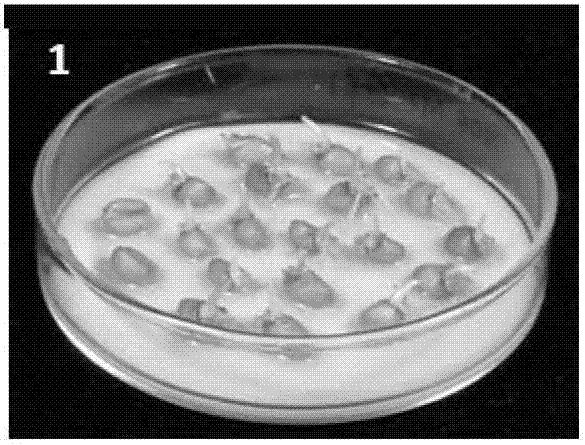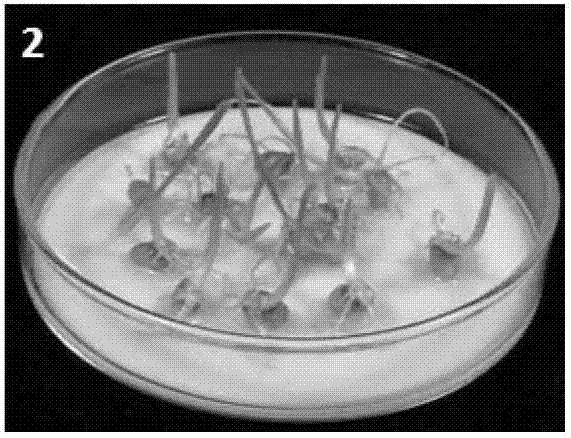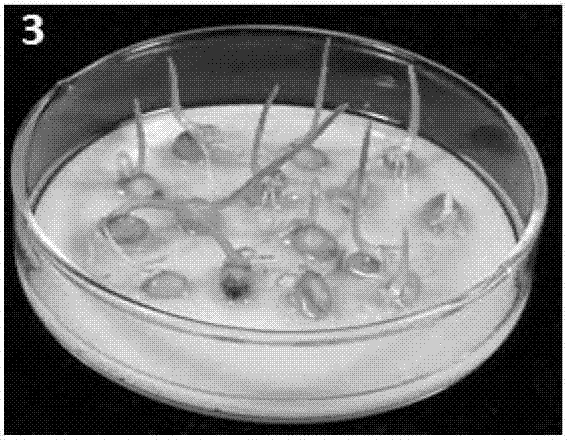Method for increasing purity of plant variety
A plant variety and purity technology, applied in the field of plant genetics and breeding, can solve problems such as direct economic losses, reduced grain production, and needs to be improved, so as to achieve the effect of ensuring purity and improving purity
- Summary
- Abstract
- Description
- Claims
- Application Information
AI Technical Summary
Problems solved by technology
Method used
Image
Examples
Embodiment 1
[0037] Example 1: Genetic segregation analysis of rice imidazolinone herbicide-resistant mutants
[0038] First, make a Huanghuazhan rice mutant plant resistant to imazapyr herbicide (DNA sequence analysis shows that the acetolactate synthase (ALS) gene of this plant exists in a heterozygous state, and the ALS mutant gene is at 1642 and 1643 A mutation occurs at the site, from TG to AT, resulting in the 548th position of the corresponding encoded protein changing from tryptophan to methionine, that is, compared to the wild-type acetolactate synthase, its acetolactate synthase has Trp548Cys mutation) since Cross fruit in order to obtain selfed seeds. Then, the inbred seeds obtained above were subjected to seed soaking experiment and seedling spraying experiment respectively by using imazamazione water agent (purchased from Shandong Xianda Chemical Co., Ltd.), the specific steps are as follows:
[0039] 1. Seed soaking experiment
[0040] Using imazapyr water solution (0.12% b...
Embodiment 2
[0051] Embodiment 2: Utilize imidazolinone herbicides to carry out rice seed soaking experiment
[0052] The imidazolinone herbicides currently produced and sold in China include imazethapyr (imazapyr), imazethapyr (Bailongtong), imazethapyr (imazethapyr), and imazethapyr (imazaquin). Utilize the above-mentioned herbicide solution to soak the rice hybrid self-fertile seeds described in Example 1 for 24 hours, take out the seeds, and carry out germination in a 32°C incubator for 24 hours, and then germinate in a 25°C incubator, After 5 days, the germination and growth of small buds were observed.
[0053] The length of the small buds of various seeds was counted, and the results showed that the length of the small buds of the herbicide-resistant seeds reached 1.5-2 cm, and the length of the small buds of the non-herbicide-resistant seeds stopped at about 0.1-0.2 cm. Then, calculate the number of resistant individuals and non-resistant individuals in the seeds after each herbic...
Embodiment 3
[0057] Embodiment 3: Utilize imidazolinone herbicide to carry out rice seedling spraying experiment
[0058]Using imazapyr, bailongtong, imazethapyr and imazethapyr to carry out field seedling spraying experiments on the rice hybrid self-fertilizing seeds described in Example 1, specifically, the seedlings at the 2-leaf stage were sprayed. Spray 87 milliliters per square meter, 2-3 weeks after the spray treatment, count the seedling survival situation, the results are shown in Table 3 below. It can be seen from Table 3 that the segregation ratio of seedling resistance to various herbicides: non-resistance is close to 3:1, which is in line with the expected dominant inheritance. The results further indicate that non-resistant seedlings can be eliminated by herbicide spray treatment, thereby utilizing herbicide resistance characteristics to ensure the purity of crop hybrid seeds during field use.
[0059] Table 3 Four kinds of imidazolinone herbicides spraying two-leaf stage se...
PUM
 Login to View More
Login to View More Abstract
Description
Claims
Application Information
 Login to View More
Login to View More - R&D
- Intellectual Property
- Life Sciences
- Materials
- Tech Scout
- Unparalleled Data Quality
- Higher Quality Content
- 60% Fewer Hallucinations
Browse by: Latest US Patents, China's latest patents, Technical Efficacy Thesaurus, Application Domain, Technology Topic, Popular Technical Reports.
© 2025 PatSnap. All rights reserved.Legal|Privacy policy|Modern Slavery Act Transparency Statement|Sitemap|About US| Contact US: help@patsnap.com



